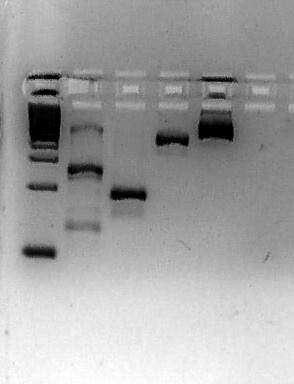
Agarose gel of PCR products (DNA fragments). Lanes: 1, ladder; 2-5, pieces-o-gene.
Since this is supposed to be a blog about science...
When people hear 'cloning', their minds often turn to Dolly the Sheep, Carbon Copy the Cat, or Glowy the Glofish and his 5,000 cousins. (There is a variety of other successfully cloned livestock, apparently.)
Cloning and genetically modified organisms manage to inspire great hysteria. "Defects in clones are common,"- true, and the phenotype is usually DEAD- "and cloning scientists warn that even small imbalances in clones could lead to hidden food safety problems in clones' milk or meat," a 'Center for Food Safety' squeaks at us. (I would like to meet these scientists.)
On the other hand, animal studies involving cloning are the backbone of much biology. Want to know what your mammalian gene does? Eventually, you're probably going to knock it out in a mouse. How? You take embryonic mouse cells, genetically modify them so the gene in question is terminally screwed up, culture a bunch of cell clones (i.e. you put the cells on a plate and they grow into clonal, or identical, populations), transfer some cells back to an early-stage mouse embryo, and stick the whole deal back in a mouse.
But I'm not going to talk about any of that.
No, let's talk about PCR, which revolutionized biology in ways that cloning may never achieve. Making a million copies of DNA bits, rapidly and cheaply, made everyone's lives a great deal easier. Back in the day, one could get a PhD- a whole PhD!- for cloning and sequencing a single gene. Nowadays, I can do that in a week or less, for under $100.
Next: How PCR Works (More Than You Ever Wanted To Know)